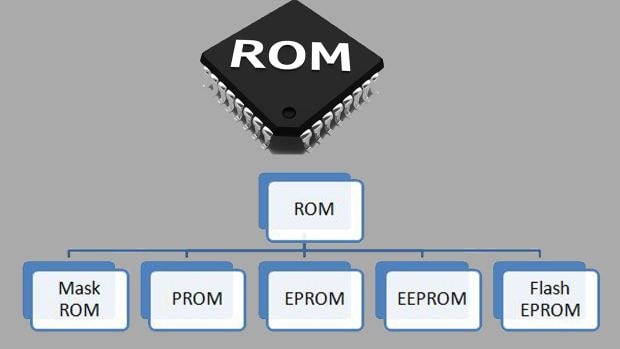Types Of ROM With Examples
Table of Contents
In computer science, any device that has the ability to store information is called memory. One such type of memory is ROM. In this article, I want to talk only about the computer ROM, the function of this piece of hardware, and the types of ROMs.
What Is ROM?
ROM stands for Read-Only Memory, which means read-only memory. As the name implies, these memories are made for reading only, and the information on them cannot be changed. The information in this type of memory is written to the manufacturer and can no longer be changed.
Inside the circuits are diodes and transistors that store this information. Of course, this is specific to early generations of ROMs.
Types Of ROM
There are different types of ROM such as MROM, PROM, EPROM, and EEPROM. EPROM and EEPROM memories can be erased and restored by special methods such as applying high voltage.

- MROM
- PROM
- EPROM
- EEPROM
MROM
Mask ROM (MROM) chips hold a software mask that is burned onto the chip through the design phase of the semiconductor manufacturing process.
Types of computer systems that use Mask ROM chips or MROM chips are network operating systems and server operating systems. Other computer systems normally use a diverse computer memory type.
To produce Mask ROM (MROM) chips, ICs are masked through the design phase of the semiconductor fabrication process. Design development for a mask ROM chip or MROM chip includes transistor width and placement.
PROM
ROM or Programmable Read-Only Memory is a type of ROM in which users write the information. This is done using a special device or device called the ROM Programmer or Burner. Also, after setting PROM bits, it can no longer be changed.
The structure of the PROM is similar to that of a ROM, but a fuse is used in each bit of its row column. The programmer’s job is to burn the fuses. When the fuse is healthy, it means that it is one bit. Usually, the chips are activated with a current of 5 volts.
And when we write or program a PROM chip, more current than we run 5 volts, which is more than 12 volts that burns the fuses of the addresses we want. Remember, you can always convert one to zero, but not vice versa.
EPROM
EPROM is a type of ROM that can be reprogrammed and erased over and over again. The method of deleting data is very different. It comes with a quartz valve through which a specific frequency of ultraviolet light is transmitted for about 40 minutes to clear the data.
Therefore, its content is preserved as long as it is not exposed to ultraviolet light. To reprogram the EPROM, you need a special device called a PROM programmer or PROM burner.
EEPROM
ln electrically Erasable Programmable Read-Only Memory all difficulties to change the information in EPROM are eliminated by using this type of ROM. Because we do not need to separate the memory and put it under special devices to erase the data.
We can specify the bits we need to erase and we no longer need to erase all the bits. Ultraviolet light is not required to clear any other bits, and electrons can be separated from transistors by creating an electric field. Deleting can also be done bit by bit. This is done slowly.
You will not need to remove the chip from the motherboard to rewrite.
Part of the data can be edited and there is no need to delete all the data.
Like PROM and EPROM, you do not need a device or peripheral.
Flash Memory
Flash Memory is also a special type of EEPROM memory, although this type of memory is faster than EEPROM memory because data is written in 512-byte blocks instead of one byte.
ROM Vs RAM
- The first difference is their names, one is Random Access Memory and the other is Read-Only Memory.
- The second difference is in the storage of information, which keeps the data RAM short-term, and the long-term RAM stores the information.
- The next difference is in writing information on them, which is simple in RAM and happens many times, but in ROM it requires special methods and as few as possible.
- Another important difference is that if the power goes out and your device shuts down, the data in the RAM will be erased, but the information in the ROM will remain unchanged.
- Their speed is another difference that is faster in Rome than in RAM.
- Another difference between the two is the size of their capacity. RAM has a much larger capacity than RAM.
Final Words
In this article, we got familiar with the internal structure of ROMs, and then we reviewed the types of ROMs, and we also get detailed information about types of ROMs. I hope you understand it very well. If you still have any quires, write us in the comment section. We will definitely respond as soon as possible.


